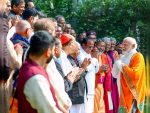By Joanna Slater
Gurugram, May 19, 2019: For Abdullah Ashraf, the changes in his country can be measured by the things he no longer does.
He never used to worry about wearing clothing that could identify him as Muslim. Now, when he goes on a road trip, he sticks to wearing jeans and a T-shirt. After his family celebrated a major holiday, they would bring goat meat from the feast back from the countryside. Today, it is a risk they will not take: The meat could be mistaken for beef by self-described “cow protection” vigilantes.
Until last year, Ashraf, 32, gathered with other Muslims in a park near the office of his outsourcing company for midday Friday prayers. Then Hindu extremists targeted such outdoor meetings in this suburb of Delhi that epitomizes India’s economic rise. They brandished sticks, shouted slogans and shoved worshipers. Now Ashraf prays in a spot designated by the police: an unpaved parking lot studded with rocks.
Such concerns — the unease about travel, the possibility of being assaulted — were not part of his life before the current government came to power.
“Sometimes I think, ‘Why do I fear to go out in my own country?’ ” he said. “This is the truth of India now.”
Five years ago, Indian Prime Minister Narendra Modi swept to power on promises to deliver jobs and development to this nation of more than 1.3 billion people. He also espoused a brand of religious nationalism that views India as fundamentally a Hindu nation and rejects the secularism promoted by the country’s founders.
As Modi seeks reelection in voting that concludes this month, the result is being closely watched by India’s nearly 200 million Muslims. Under his government, their worries have increased, while their space to express their unease has shrunk. Although Muslims make up about 14 percent of the population, Modi’s Bharatiya Janata Party has no Muslim members in the lower house of Parliament — the first time for a ruling party in India. In the current campaign, senior BJP leaders have engaged in anti-Muslim rhetoric.
Meanwhile, reports of violence by Hindu extremists have increased in recent years, including lynchings in the name of protecting cows, which are considered sacred by some Hindus. The lack of prompt condemnation by Modi further unsettled the Muslim community: He directly denounced such violence two years after the first prominent case shook the country.
The Modi government notes that no large-scale Hindu-Muslim riots have occurred on its watch, unlike under previous central governments controlled by the opposition Congress party and the BJP.
BJP leaders also accuse the Congress party, which governed India for most of its post-independence history, of pandering to Muslim voters.
Here in Gurugram, a city that underwent a dizzying transformation from farmland to gleaming office parks, the changes in the past five years are less about violence than an increasingly assertive Hindu identity. In 2016, the city changed its name from Gurgaon to Gurugram — village of the guru — to emphasize a putative connection to Hindu mythology. Meanwhile, right-wing Hindu activists have pressured meat shops to close and pushed to limit the spots available for weekly prayers for the growing Muslim community.
Some critics say such moves risk turning India, which has long prided itself on its embrace of diversity, into a place where Muslims are effectively second-class citizens.
“Muslims belong to this land. They’re part of the [country’s] DNA,” said Mohammad Hamid Ansari, who served as India’s vice president for a decade under both Congress and BJP governments. Now those in power are deliberately creating an atmosphere where it is the “80 percent versus the rest,” he said.
At stake in this election is the trajectory of the world’s largest democracy. If Modi returns to power with a strong mandate, “India will become an irrevocably majoritarian state,” Pratap Bhanu Mehta, a political scientist and vice chancellor of Ashoka University, said in a recent speech. “Basic assumptions we made about Indian democracy . . . will be up for grabs.”
The Modi government rejects such critiques.
“Any kind of speculation on, ‘Oh, minorities are in trouble,’ is absolutely baseless,” Nirmala Sitharaman, the country’s defense minister, told reporters on Friday. “As much as Hindus, as much as Jains and Parsis, Muslims are also part of India, and that’s how we treat them.”
‘Why not sell peanuts?’
Gurugram’s main mosque, the Jama Masjid, is a cream-and-red structure built when the city was still a sleepy town south of India’s capital surrounded by farms. But starting in the early 1990s, developers began snapping up chunks of land. Today, Gurugram — sometimes called India’s “Millennium City” — has luxury housing developments, a golf course designed by Arnold Palmer and office towers that house companies such as Microsoft, Coca-Cola and Facebook.
As Gurugram has grown, it has drawn migrants from other parts of India and beyond. Many of the laborers, construction workers and domestic staff who have helped power the city’s rise come from states such as Bihar and West Bengal — and a good chunk of them are Muslims. The latest census from 2011 puts the district’s Muslim population at 71,000, but community leaders say it is closer to several hundred thousand today. (The district’s total population is estimated to be more than 2.1 million.) In 2014, the same year Modi was elected prime minister, the BJP also won an election to govern Haryana, the state where Gurugram is located.
Tucked next to one side of the mosque is a meat market, a lane lined with about two-dozen small stalls. On a recent evening, flies buzzed around hunks of fresh buffalo meat hanging from hooks.
Although India has a reputation for vegetarianism, the true picture is complicated: Many Hindus eat meat and fish, as do nearly all of India’s religious minorities. Under the current government, the rhetoric around vegetarianism has grown more strident and even has been used by extremists to justify violence against people suspected of harming cows.
Last fall, a group of right-wing Hindu activists demanded that the meat shops close during the Hindu festival of Navratri, which lasts for nine nights. During Navratri, some Hindus observe a form of fasting.
The Muslim shopkeepers came up with a compromise — covering the front windows of their stalls and placing a curtain across the entrance to the market — but that wasn’t good enough, they were told. When the festival began, the activists returned and said the market had to close completely, said Akram Khan, a shopkeeper. For the first time in the market’s 60-year history, it shut down during the Hindu festival last year.
“This has never happened before,” said Khan, who said more than 100 workers were affected by the move. Asked what the response would be had the shopkeepers refused to close, he stared back at the questioner. “You know what would happen,” he said, unwilling to say more.
The activists who pushed the market to close were part of the Joint Hindu Struggle Committee, an umbrella group of 22 right-wing Hindu outfits with chapters in Gurugram. Rajeev Mittal is a leader of one such organization, the All India Hindu Revolution Party.
The sight of meat during the Navratri festival “hurts our feelings,” said Mittal, sitting in a small office above a clothing store, a saffron scarf around his neck. “If we want peace and brotherhood, why not sell peanuts or yogurt or milk?”
Mittal said he helped organize groups of activists to go to meat shops and tell them to close. Asked whether such requests could be interpreted as threats, he shrugged. “It’s how you perceive it,” he said.
‘Everyone was shocked’
Another issue that united the Hindu fringe in Gurugram was Muslims holding Friday prayers in places across the city, including in parks, plazas and on vacant land. Muslims say they pray outdoors because they have no choice. There are few mosques in Gurugram, and efforts to open new ones have been met with stiff resistance, said Mufti Mohammed Saleem Qasmi, a cleric at the Jama Masjid. The midday Friday prayers cater to hundreds of thousands of Muslims living and working in Gurugram, though only a fraction attend.
Last year, Hindu activists disrupted Friday prayers, first at one location in April, then at numerous locations the following month.
Shahid Khan, 48, has run a steel-fabrication workshop in Gurugram since 1996. On a Friday afternoon last year, he was at his regular spot for prayers when he saw a large group of men approaching with saffron flags and chanting “Jai Shri Ram,” or “Victory to Lord Rama,” a Hindu god. They told the Muslim men to leave, shoved them and threw their prayer mats, Khan said. When the worshipers moved to another location nearby, the activists followed them.
“Everyone was shocked and confused,” Khan said. “No one understood what was happening and what to do.”
Right-wing Hindu groups say the worshipers, who pray together for about 15 minutes, were blocking traffic or violating municipal regulations. “We are not saying don’t worship, we are saying everyone has a limit,” said Rituraj, who goes by one name and leads another little-known outfit — the Hindu Sena, or Hindu Army — in Gurugram. “They can come, they can work . . . [but] it’s my land; you can’t come and occupy it.”
Members of his group were recently arrested and accused of issuing fresh threats to meat shops.
On a recent Friday afternoon, dozens of Muslim men arrived at a vast parking lot bounded by office towers, construction sites and a theme park called Kingdom of Dreams. The temperature hit 98 degrees as the dusty expanse baked under a cloudless sky. They washed their faces and hands in the shade of nearby trees. Then they removed their shoes near a makeshift tent and began to pray.
They were professionals and sales managers and rickshaw drivers, many of whom had lived in Gurugram for years. “We are disappointed by the government,” said Naseem Khan, 48, gesturing at the less-than-ideal surroundings. “We are Indians, this is our country, and still we face these problems.”
Next to him stood his friend Shahid Khan, the steelworker. “I used to feel safe here,” he said. Now “anything can happen at any time.”
(The Washington Post)








